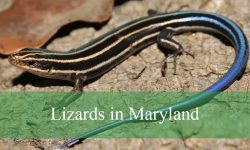There are many different types of caterpillars in Alabama, and they all have distinctive traits and eye-catching hues. The Black Swallowtail Caterpillar (Papilio polyxenes), a huge green caterpillar with characteristic black and yellow stripes surrounding each segment, is one noteworthy species. It’s not covered with spikes, spines, or horns like some caterpillars are. The Monarch Caterpillar (Danaus plexippus), another intriguing resident, is distinguished by its striped and horned look in vivid yellow, white, and black hues. These caterpillars only consume milkweed plants, storing toxins as a line of defense.
The Eight-Spotted Forester Caterpillar (Alypia octomaculata), an orange caterpillar with black and white stripes all over its body, is also found in Alabama. Its segments have characteristic feathery spines that enhance to its unusual appearance, and its tubercles are black and resemble tiny round dots. The Common Pine Sawfly Caterpillar (Diprion pini), which has a light green body with black markings on its sides and a single black line along its back, is another fascinating insect. After pupating, this caterpillar becomes a pine sawfly, a kind of wasp.
These are simply a few instances of the many different types of caterpillars that Alabama’s varied ecosystems support, adding to the state’s biodiversity and displaying the complex beauty of its insect residents. To learn more about caterpillars in Alabama, please read the article below.
Different Types of Caterpillars in Alabama
Azalea Caterpillars
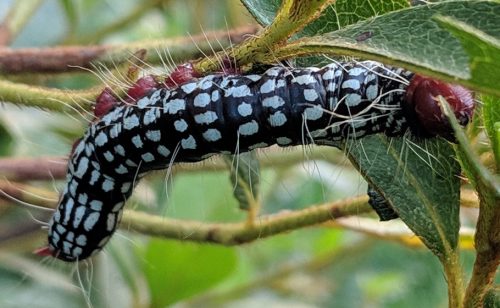
Scientifically known as Datana major, Azalea Caterpillars are characterized by their black bodies adorned with vibrant green bands. These conspicuous larvae boast a distinctive appearance with round orange heads and tail sections. Recognizable through their striking green, black, and orange markings, these voracious caterpillars pose a threat to the foliage of blueberry, apple, and oak trees.
Gulf Fritillary Caterpillar

Scientifically identified as Dione vanillae, the Gulf Fritillary Caterpillar distinguishes itself with spiny projections surrounding its orange segments. Notable features include grayish-black stripes that run along its back, facilitating straightforward identification. Typically located on passion flowers, these caterpillars showcase a sleek orange body embellished with prominent blackish stripes and conspicuous spines.
Spicebush Swallowtail Caterpillar
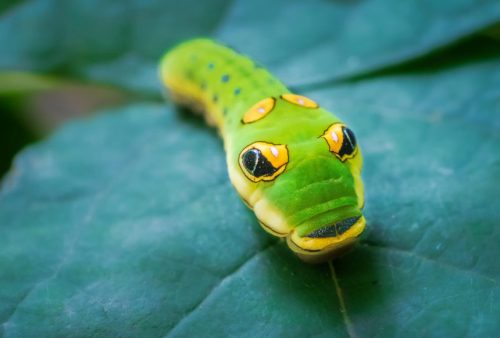
Scientifically identified as Papilio Troilus, the Spicebush Swallowtail Caterpillar presents a distinctive appearance as a unique green caterpillar in Alabama. It showcases large eye markings on its head, transitioning from brown to green and ultimately adopting a yellowish hue in its final growth stage. Each segment is adorned with distinctive blue circular patterns. Remarkably, eyespot markings on the head are created by black circles surrounded by yellow rings. Typically inhabiting sweet bay and spicebush, this caterpillar displays exceptional features for easy identification.
Redhumped Caterpillar
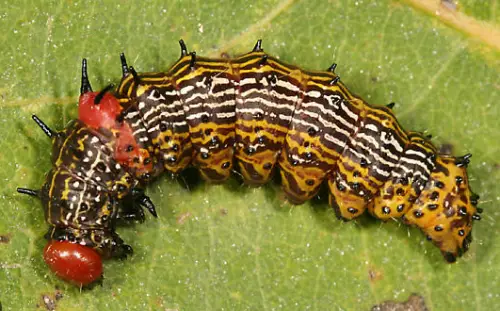
Scientifically designated as Schizura concinna, the Redhumped Caterpillar derives its name from the conspicuous red hump on its back. Distinguished by yellow and white stripes, soft horn-like protrusions, cherry-red circular heads, and feathery spines, this caterpillar thrives on almond, apple, apricot, birch, and cherry trees. With its shiny black body adorned with spiny spike bands, this caterpillar in Alabama exhibits distinctive features that make it easily recognizable.
Red Admiral Caterpillar
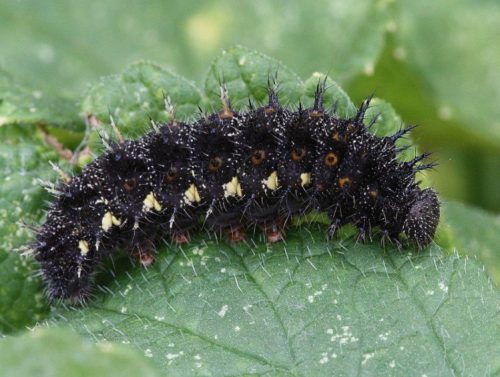
Scientifically identified as Vanessa atalanta, the Red Admiral Caterpillar is a spiky black caterpillar found in Alabama, adorned with fleshy spines and white dots along its body. As they mature, these caterpillars undergo a transformation, adopting a grayish-brown color with dark red or brown dots along their sides, reaching a length of up to 2.5cm. Their diet primarily consists of stinging nettle plants. Following the pupation stage, these caterpillars undergo metamorphosis, emerging as striking black and red butterflies that feature distinctive yellow bodies with black and white stripes.
Polyphemus Moth Caterpillar

Scientifically designated as Antheraea polyphemus, the Polyphemus Moth Caterpillar is a silk-spinning species with a light green body adorned by vibrant red dots along each segment. It is characterized by its plump physique and distinct spines emerging from red tubercles. Over the course of its growth stages, the juvenile caterpillars exhibit a bright yellow coloration that gradually transitions to green. Typically found on apple, ash, birch, elm, hazel, maple, rose, and dogwood trees, this caterpillar is identifiable by its bright green translucent body featuring rows of either red dots or silver spiny dots around its segments.
Evergreen Bagworm

Hailing from the Psychidae family, the Evergreen Bagworm is a glossy black or dark brown caterpillar found in Alabama. Its notable characteristic lies in the protective bag-like structures crafted from tree foliage, rendering it difficult to detect. These caterpillars are known for infesting and swiftly defoliating ornamental backyard trees such as black locust, elm, maple, poplar, oak, and willow, as they reside within their cocoon bags.
Yellow Forester Moth Caterpillar
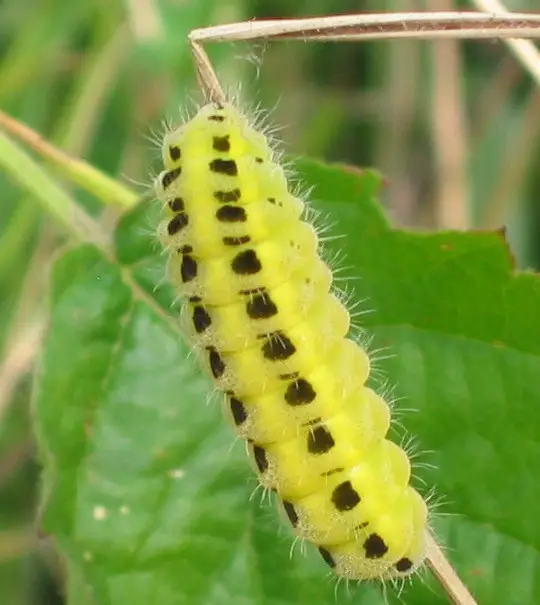
Scientifically classified under Zygaenidae, the Yellow Forester Moth Caterpillar is a vibrant yellow or yellowish-green caterpillar commonly found in Alabama. It is adorned with rows of black dots along its back and features spiny tufts on both its back and sides. Specializing in herbaceous plants, particularly the Carolina laurelcherry, these caterpillars can grow up to 12.5cm in length. Their distinctive appearance includes bright yellow bodies with pronounced black markings along their sides and back.
Tiger Swallowtail Caterpillar

Scientifically recognized as Papilio glaucus, the Tiger Swallowtail Caterpillar is a dark green species with a sleek body, featuring distinctive eye-like markings on each side of its head. Possessing a defense mechanism against birds and small predators, it sports a unique organ on its head resembling a forked snake tongue, effectively deterring potential threats. Typically residing on black cherry, Carolina ash, sweet bay, and green ash trees, this caterpillar can be easily identified by its uncommon eye-like markings and dark green abdomen.
Cecropia Moth Caterpillar
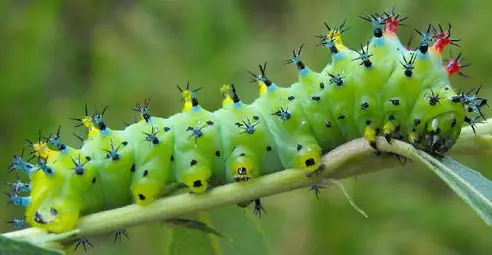
Scientifically identified as Hyalophora cecropia, the Cecropia Moth Caterpillar is an Alabama native characterized by its large, ridged segments adorned with rows of blue and orange tubercles. The lime-green body, complemented by black spikes, creates a stunning visual contrast. These vibrant green caterpillars undergo a remarkable transformation, evolving into beautiful brown moths typically observed between April and June. They are commonly found on ash, birch, box elder, alder, elm, maple, and poplar trees, distinguished by their visible segments featuring rows of blue and yellow fleshy bumps, black spikes, and numerous orange tubercles.
Cabbage Looper Caterpillars
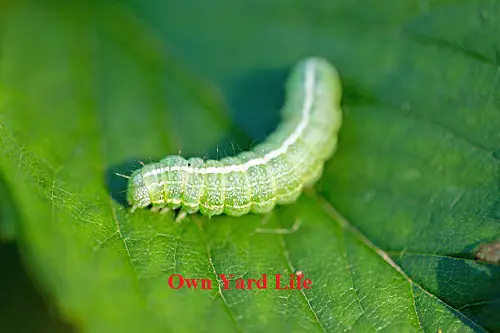
Scientifically designated as Trichoplusia ni, the Cabbage Looper Caterpillars are frequently sighted in Alabama during the spring and summer seasons. Known for their distinctive looping motion, these voracious creatures possess an impressive appetite, devouring up to three times their body weight thrice a day. Growing up to 4cm in length, they feed on a variety of plants, including tomato, soybean, pepper, and cabbage, displaying lime-green or yellow-green bodies. Their noteworthy characteristic is the distinctive looping action observed while in motion.
Luna Moth Caterpillar
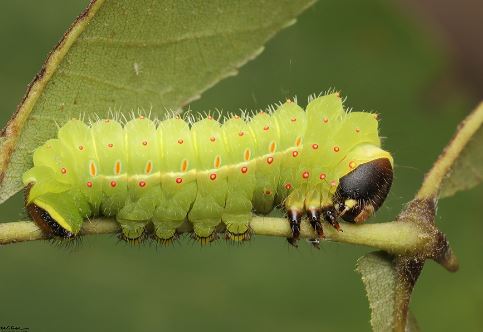
Scientifically identified as Actias luna, the Luna Moth Caterpillar showcases a lime-green body adorned with red dots at the rear and clusters of small spines. Distinctively known for elevating the front part of its body while in motion, these caterpillars primarily feed on birch, walnut, hickory, American sweet gum, and maple trees. Growing up to 9cm in length due to their voracious appetite, they can be recognized by their brown head, a prominent line of bright red dots running lengthwise, and three pairs of brown forelegs.
Forest Tent Caterpillars
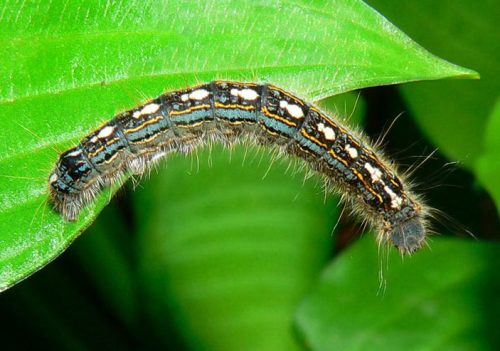
Scientifically classified as Malacosoma disstria, the Forest Tent Caterpillar is an Alabama native displaying a dark body adorned with yellow lines, lateral blue bands, and distinctive white patches. Recognizable for its feathery spines along the sides, this caterpillar is frequently sighted during the spring and summer months. Its diet includes willow, oak, birch, elm, and maple tree leaves. Identifiable by its blackish-brown appearance, it features prominent blue, yellow, and black lines running lengthwise along its back.
Zebra Longwing Caterpillar
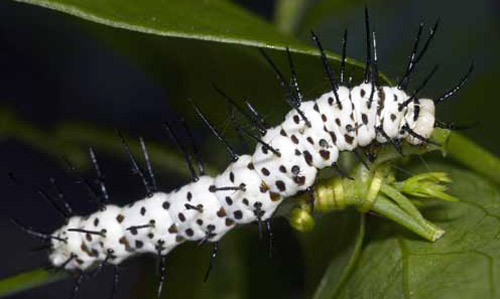
Scientifically known as Heliconius charithonia, the Zebra Longwing Caterpillar is a pale-gray species with elongated black fleshy spikes, frequently encountered in Alabama and other Southern United States regions. Adorned with fine spines, this caterpillar sustains itself by feeding on passionflower vines, accumulating toxic substances in its body. The venom serves as a potent defense mechanism, imparting a foul taste to predators.
Long-Tailed Skipper Caterpillar
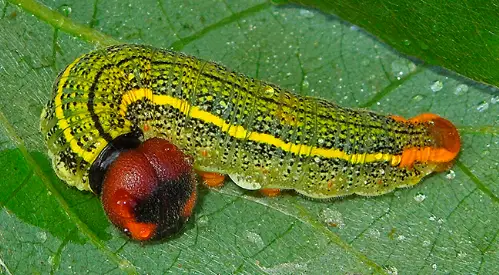
Scientifically identified as Urbanus proteus, the Long-Tailed Skipper Caterpillar is a sizable, slug-like caterpillar in vibrant green hues, marked with rings of yellow spots around its segments and a lateral greenish-yellow line along its back. Commonly referred to as the bean leafroller, it boasts a distinctive black globular head and showcases orange patterns on its tail. As these caterpillars mature, they transition to a pale green color with the development of pinkish patterns. Typically found on beans, peas, hog peanuts, and wisteria plants, key identification features include a spherical head, yellow markings, and prominent orange prolegs.
Cloudless Sulphur Caterpillar

Scientifically referred to as Phoebis sennae, the Cloudless Sulphur Caterpillar is a pale green species adorned with black raised dots that give rise to minute spines. Soft yellowish spines envelop both the prolegs and abdomen, while an additional distinctive feature is the pale-yellow stripe running along its sides. Typically located on Maryland wild-sensitive plants, these caterpillars are recognizable by their green bodies decorated with bluish-black dots, light yellowish short spines, and a prominent yellow lateral band along their sides.
White-Marked Tussock Caterpillar
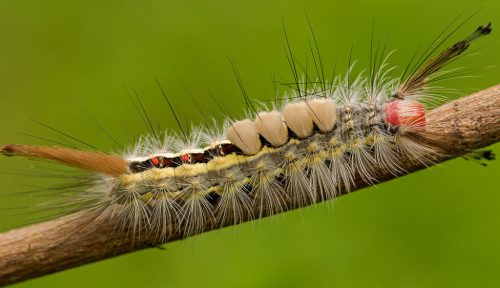
The multicolored body of the White-Marked Tussock Moth Caterpillar (Orgyia leucostigma) is enhanced by black tufts that mimic antennae and long white hairs. Its striking appearance includes an impressive red head and red spots around the mid-dorsal area, creating a remarkable sight. Contrasted with yellow stripes, the majority of its body is predominantly black. While commonly found on rose petals and other flowers in gardens, it also feeds on fruit and hardwood trees such as oaks and apples. Despite experiencing multiple outbreaks, these caterpillars eventually succumb to a contagious illness.
Tobacco Hornworm Caterpillar
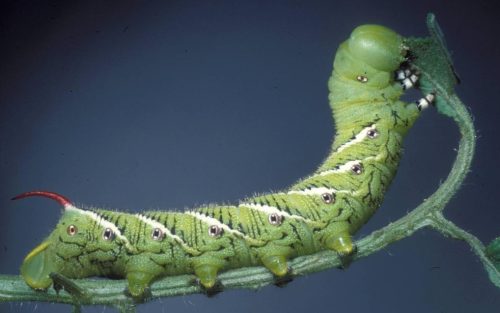
The Tobacco Hornworm, scientifically known as Manduca sexta, is a lively green caterpillar embellished with eyespot markings and distinctive white diagonal stripes running along its sides. Growing up to a length of 7cm, it is characterized by a prominent rear horn in shades of brown, green, or orange. Known for its dietary preferences, this caterpillar feeds on the foliage of tobacco, tomato, and eggplant plants. While sharing similarities with tomato hornworms, the Tobacco Hornworm stands out with its unique diagonal stripes. Its host plants encompass tobacco, tomato, pepper, eggplant, and various ornamental shrubs.
Pipevine Swallowtail Caterpillar
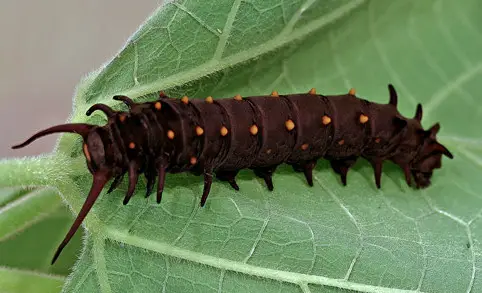
The Pipevine Swallowtail Caterpillar, scientifically named Battus philenor, showcases a deep brown coloration complemented by fleshy horns on its head, tail, and sides. Standout features include two rows of vivid orange dots along its back, facilitating straightforward identification. This caterpillar, adorned with fine hairs for a velvety texture, can attain a length of 5cm, thanks to its voracious appetite. Thistle flowers and ironweed plants serve as host plants for this species.
Imperial Moth Caterpillar
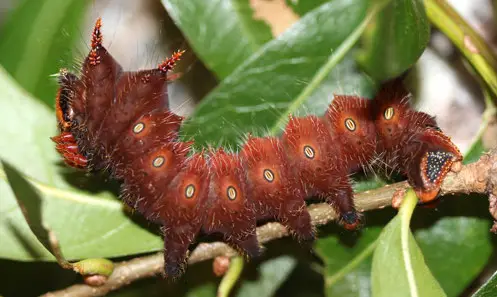
The caterpillar of the Imperial Moth, scientifically identified as Eacles imperialis, features extended spiky horns on its head and a jagged tail-like protrusion. Displaying a color spectrum ranging from orange-brown to dark brown or dark green, it can reach lengths of 7.5 to 10cm. This caterpillar undergoes notable color transformations, with mature individuals adopting a darker and hairier appearance, signaling their transition to the pupation stage. Typically located on the foliage of pine, maple, oak, sweetgum, and sassafras, it presents a captivating species at various stages of its growth.
Hickory Horned Devil Caterpillar
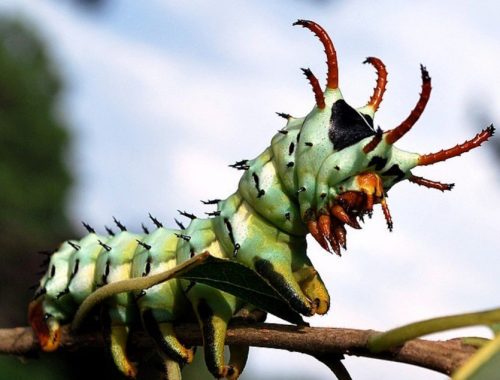
The Hickory-Horned Devil, scientifically designated as Citheronia regalis, is an intriguing and non-threatening caterpillar commonly observed in Alabama. Featuring a bluish-green body embellished with curved spiny horns and black tips, it sustains itself by feeding on the leaves of walnut, hickory, pecan, and sweetgum trees. Notable for its orangey-red head and formidable red horns, this sizable insect undergoes a remarkable metamorphosis, emerging as a majestic moth after the pupation stage.
Stinging Rose Caterpillar
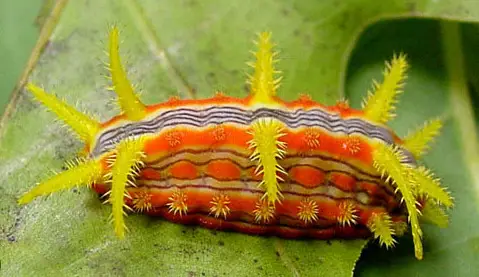
The Stinging Rose Caterpillar, scientifically identified as Parasa indetermina, is a vibrant and venomous species distributed along the East Coast from New York to Alabama. Sporting a yellow or orange-red body adorned with delicate bands of purple stripes, it stands out with jagged horn-like spikes along its back and clusters of spines along its sides. Growing up to 2.5cm in length, these caterpillars nourish themselves on hickories, oaks, poplars, dogwood, and rose bushes. Handling them should be approached with caution, as their venomous spines can cause skin irritation.
Spiny Oak Slug Caterpillar

Scientifically known as Euclea delphinii, the Spiny Oak Slug Caterpillar is a vivid and stinging caterpillar characterized by jagged spikes. Notable features include four pairs of upward-pointing spiked orange horns, accompanied by two orange bands adorned with circular green and white markings along the back. These spikes contain venom that can induce skin irritation. These caterpillars are commonly found on various deciduous trees and shrubs, and they feed on the foliage of a diverse range of trees including apple, ash, birch, basswood, oak, maple, poplar, hackberry, beech, blueberry, and more.
Buck Moth Caterpillar
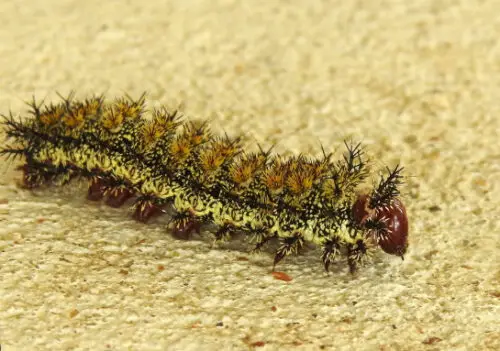
Scientifically identified as Hemileuca maia, the Buck Moth Caterpillar holds the distinction of being Alabama’s largest stinging caterpillar. Its imposing appearance is characterized by a black body adorned with small white dots and jagged tufts of spines. Caution is advised when handling these caterpillars, as their spines carry venom that can cause skin irritation and redness. Featuring a unique round and shiny black head, they primarily feed on the leaves of scrub oak, live oak, blackjack oak, and dwarf chestnut oak. It’s recommended to avoid direct contact with these crawling insects to prevent unpleasant stings.
Monkey Slug Caterpillars
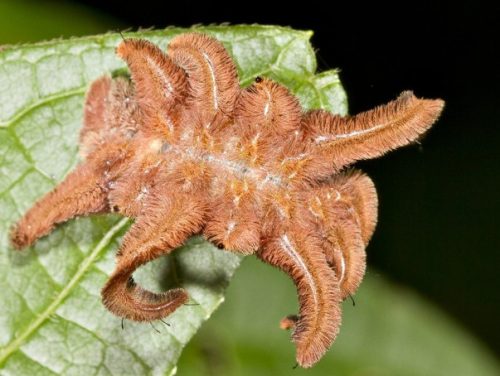
Scientifically identified as Phobetron pithecium, the Monkey Slug Caterpillar is an unusual brown and fuzzy caterpillar native to Alabama. Featuring a flattened furry body and nine pairs of distinctive projections along the sides, it presents a unique appearance reminiscent of a deceased hairy spider or an aged leaf. Caution is recommended, as it possesses the capability to sting, and contact without protective gear may result in pain due to its venom. Discovered on various trees including apple, ash, birch, dogwood, hickory, oak, walnut, and willow, this diminutive caterpillar adds a distinctive touch to the local environment.
Southern Flannel Caterpillar
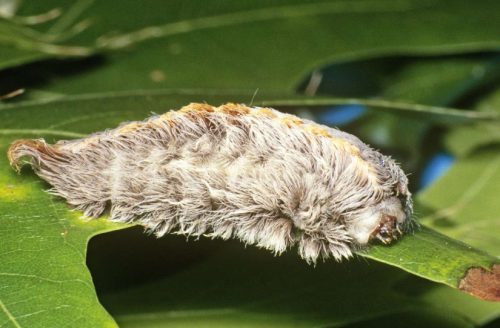
The Southern Flannel Caterpillar, commonly referred to as the puss caterpillar, is a furry caterpillar equipped with concealed poisonous spikes that can inflict severe stings. Prevalent in the Southern States, particularly on oak and elm trees, it is strongly recommended to avoid direct contact with these larvae to prevent intense pain caused by their venomous spines. Resembling a Persian cat, this caterpillar is also known as asp larvae, alluding to the painful sting comparable to a snake bite. Scientifically named Megalopyge opercularis, it boasts a brown, furry appearance with a broad rounded head, reaching a length of up to 2.5cm.
Io Moth Caterpillar
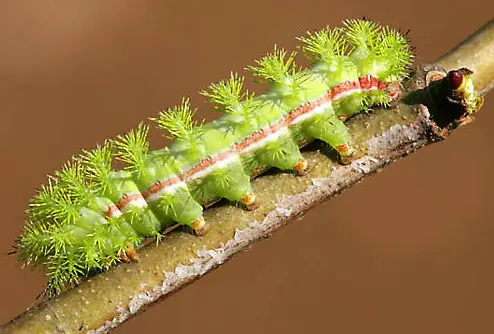
Scientifically identified as Automeris io, the Io Moth Caterpillar is a green species equipped with stinging hairs on its four sets of prolegs. Displaying pale-green tones and bands of vivid green tufts of hair around its abdomen, it is easily recognizable by its distinctive red and white stripes along the abdomen. Handling these caterpillars without protective gear can result in a burning sensation, unpleasant rashes, and pain. Typically located on hackberry, willow, redbud, pears, and blackberry plants, these crawling insects can attain a length of up to 6cm.
Saddleback Caterpillar
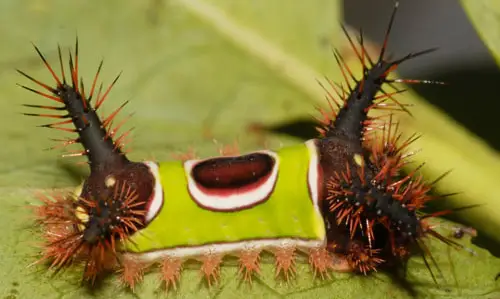
Scientifically designated as Acharia stimulea, the Saddleback Caterpillar is a slug-like caterpillar found in Alabama, featuring venomous spikes on its back. Distinguished by a conspicuous saddle-like marking on the middle section, it is easily identified by a square green patch and a large brown circle. Growing up to 2.5cm, its menacing appearance is accentuated by stinging spines along the abdomen and horns at both ends. Discovered on various plants such as apple, asters, blueberries, corn, citrus, dogwood, elms, and grapes, caution is strongly recommended when encountering this distinctive species.
Milkweed Tiger Caterpillar
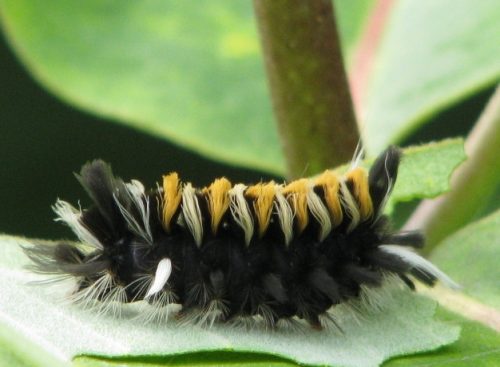
Scientifically known as Euchaetes egle, the Milkweed Tiger Caterpillar is a diminutive and hairy caterpillar distinguished by colorful tufts of white, black, orange, and yellow hair. Sporting a distinctive hairy brown body with orangey spiny tufts on the back, it showcases tan-colored tufts on its sides, contributing to its unique appearance. Typically found feeding on milkweeds and dogbane plants, it is advisable to avoid touching them to prevent potential skin irritation caused by their hairs.
Giant Leopard Caterpillar
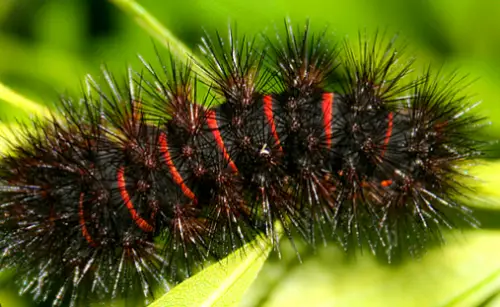
Scientifically identified as Hypercompe scribonia, the Giant Leopard Caterpillar is a prevalent black, spiky caterpillar found in the southeastern United States. Distinguished by its prominent red bands situated between sharp spines, its fuzzy appearance and spiked body have the potential to cause pain if the spikes penetrate human skin. With a length reaching up to 5cm, this crawling insect feeds on a variety of plants, including banana, cherry, cabbage, maples, sunflowers, violets, and willows.
Banded Woolly Bear Caterpillar

Scientifically known as Pyrrharctia isabella, the Banded Woolly Bear Caterpillar is a common black and brown fuzzy caterpillar in Alabama. Recognizable by the wide rusty brown band encircling its black body, it boasts an oblong shape with fuzzy spines, making it challenging to discern the head and tail. Despite its appearance, these caterpillars are neither stinging nor poisonous. In response to threats, they have a defensive behavior of rolling into a ball shape. Typically found on plantain, aster, dandelion, goldenrod, and certain grasses, these crawling creatures showcase distinctive features with two black bands at both ends and a brown band around the middle section.
American Dagger Moth Caterpillar
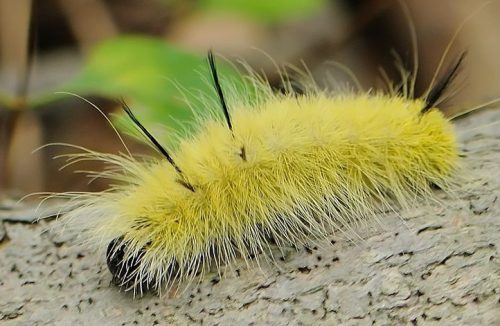
Scientifically identified as Acronicta americana, the American Dagger Moth Caterpillar is a pale yellow moth caterpillar adorned with long black pencil hairs. Recognizable by its fuzzy yellow body and glossy black oval head, it possesses spiny hairs that can induce skin irritation and rashes upon contact. Typically discovered on alder, ash, elm, maple, oak, willow, and various hardwood trees, these furry caterpillars showcase distinctive yellow feathery spines with two pairs of long pencil hairs on their backs.
Tomato Hornworm Caterpillar
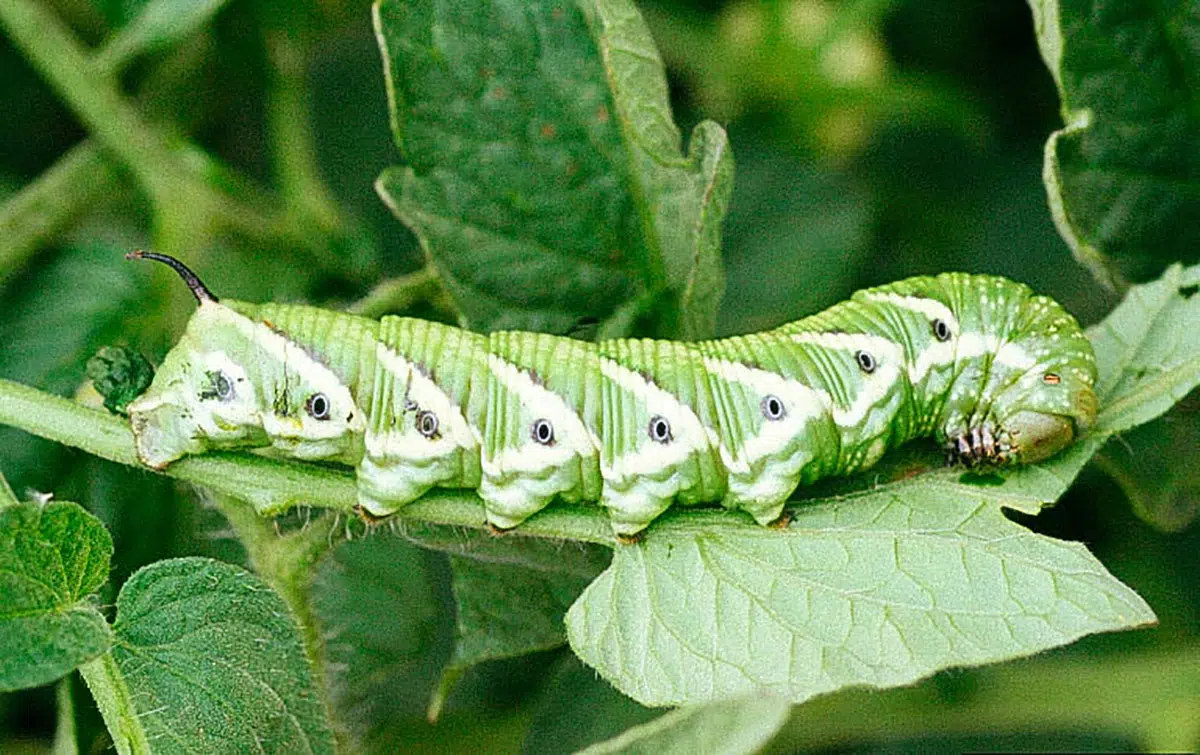
Scientifically designated as Manduca quinquemaculata, the Tomato Hornworm Caterpillar is a vibrant green garden pest adorned with rows of eyespots and distinctive V-shaped markings. Noteworthy for its pointed black tail projection, resembling a horn, it exhibits a voracious appetite for tomato foliage. Reaching lengths of up to 10cm, it can be challenging to detect on tomato plants, thanks to its effective leaf camouflage. To manage infestations, chemical treatments are suggested.
White Admiral Caterpillar
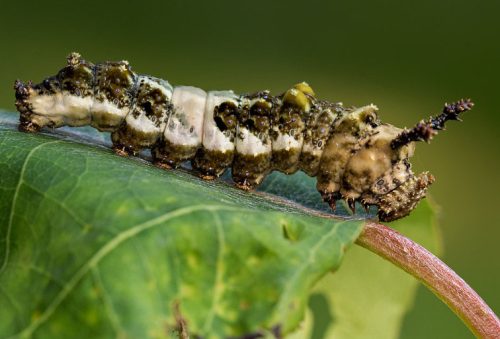
Scientifically identified as Limenitis arthemis, the White Admiral Caterpillar is an Alabama native that employs a unique camouflage strategy, resembling bird droppings on branches to discourage predators. Distinguished by its light green and brown body adorned with irregular white blotches and two long black horns on the head, it sustains itself by feeding on willow, aspen, poplar, and birch leaves. Following the pupation stage, these caterpillars undergo a remarkable transformation into vibrant iridescent blue and orange butterflies.
Common Pine Sawfly Caterpillar
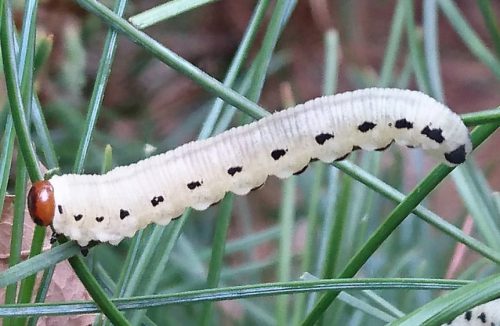
Scientifically referred to as Diprion pini, the Common Pine Sawfly Caterpillar is a light green species marked with black spots on its sides and a single black line along its back. Typically located on Scottish pines, this caterpillar undergoes a transformation into a pine sawfly, a type of wasp, after the pupation stage. Distinctive features include a rusty red head that transitions to pale yellow and becomes translucent in its final growth stages, featuring fake eyespots before entering pupation.
Eight-Spotted Forester Caterpillar

Scientifically identified as Alypia octomaculata, the Eight-Spotted Forester Caterpillar is an orange species in Alabama adorned with black and white stripes encircling its body. Each segment features black tubercles resembling small round dots. Noteworthy characteristics include visible feathery spines, four sets of prolegs, and three sets of pointed forelegs. Discovered on grape and Virginia creeper plants, this caterpillar showcases distinctive thick black-spotted orange stripes, tufts of thin spines, and conspicuous white and black stripes.
Queen Butterfly Caterpillar
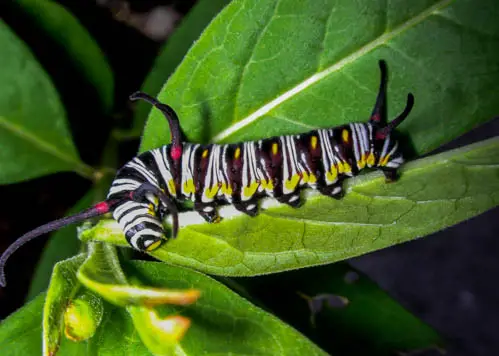
Scientifically designated as Danaus gilippus, the Queen Butterfly Caterpillar features black and white stripes along with distinctive yellow dots on its back and sides. Noteworthy characteristics include six large fleshy tentacles on both the head and tail. Reaching a length of up to 5cm, it sustains itself by feeding on milkweed, frogfruit, and mistflower plants. Recognizable by its black and white stripes and yellow dots, this caterpillar undergoes a captivating transformation into a beautiful Queen Butterfly.
Black Swallowtail Caterpillar
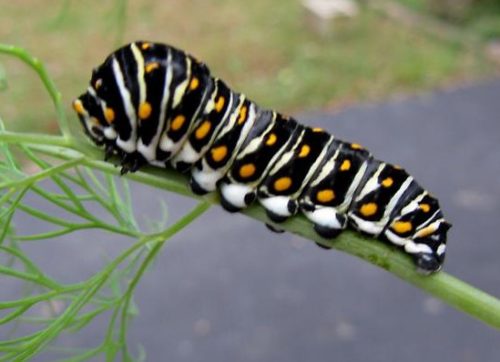
Scientifically identified as Papilio polyxenes, the Black Swallowtail Caterpillar is a sizable green species found in Alabama, characterized by distinct black and yellow stripes around each segment. Unlike certain caterpillars, it does not possess horns, spines, or spikes. Nourishing itself on milkweeds, carrots, dill, parsley, and fennel, its smooth body and vibrant colors act as a deterrent to potential predators who perceive it as a potentially dangerous species.
Monarch Caterpillar
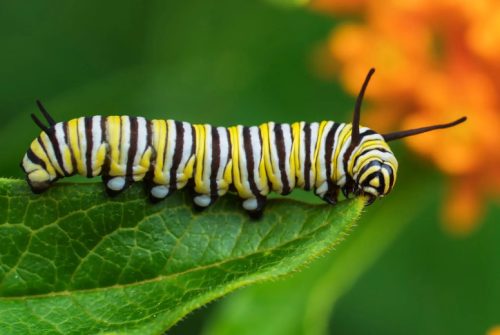
Scientifically designated as Danaus plexippus, the Monarch Caterpillar is a striped and horned species in Alabama, featuring bright yellow, white, and black colors around its body. Each segment is marked by conspicuous colorful bands, with long black horns on the head and shorter ones on the tail serving as distinctive features. Reaching a length of up to 5cm, these caterpillars display white dots on the prolegs and black forelegs. Exclusive consumers of milkweed plants, they accumulate toxic substances in their bodies as a defense mechanism.
People Who Read This Also Read:





